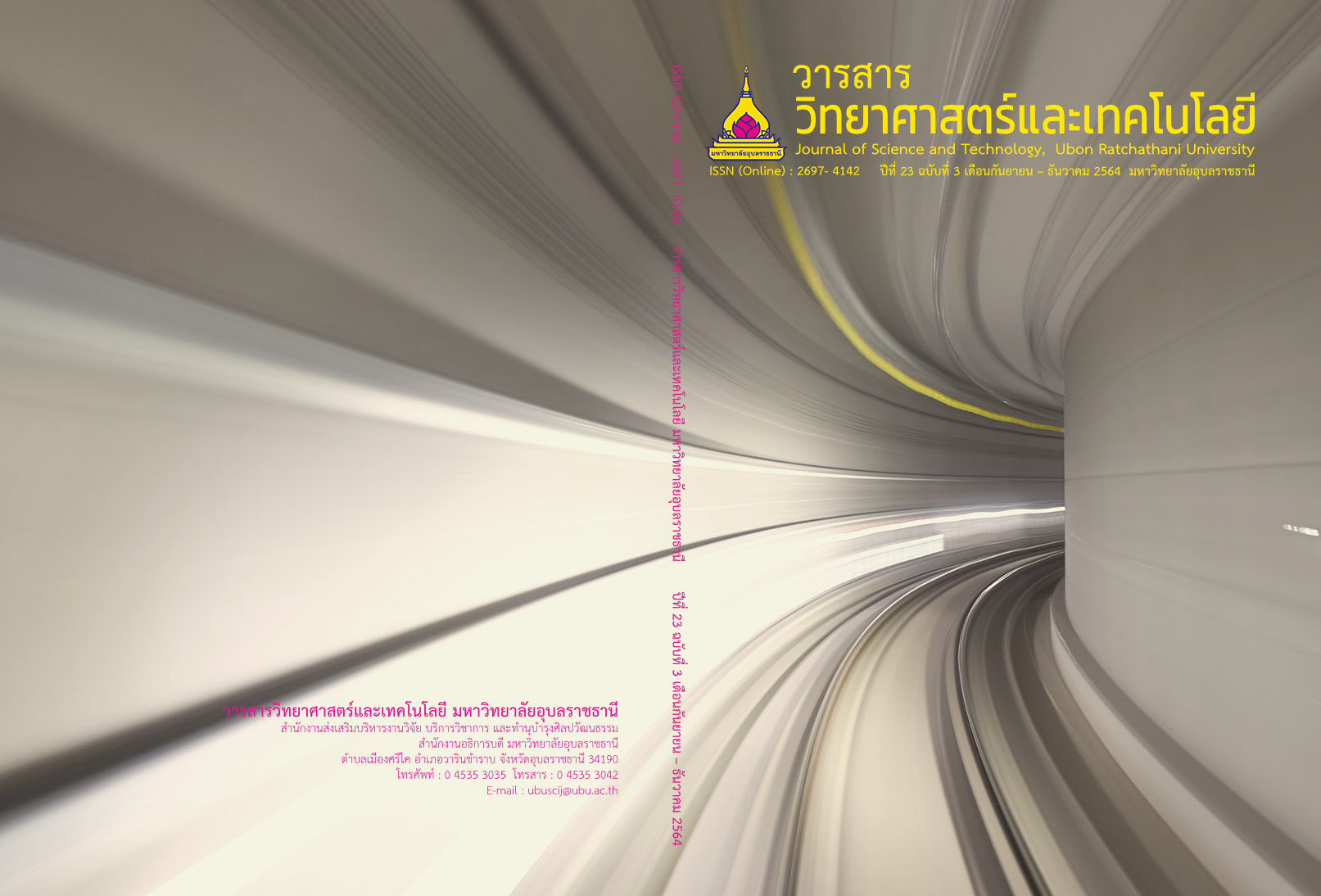การเจริญเติบโตและผลผลิตของเห็ดขอนขาว (Lentinus squarrosulus Mont.) ที่เพาะเลี้ยงในวัสดุก้อนเชื้อต่างชนิดกัน
Main Article Content
บทคัดย่อ
ในอนาคตข้างหน้าเป็นที่คาดกันว่าเมล็ดข้าวฟ่างจะขาดแคลน และมีราคาแพง เนื่องจากการลดปริมาณการผลิต และความต้องการที่เพิ่มขึ้นเพื่อใช้เป็นอาหารสัตว์ และผลิตเอทานอล ดังนั้นการหาวัสดุอื่นเพื่อมาแทนที่เมล็ดข้าวฟ่างในการเพาะเชื้อเห็ดจึงมีความสำคัญ การวิจัยนี้มีวัตถุประสงค์เพื่อศึกษาการเจริญเติบโตและผลผลิตของเห็ดขอนขาว (Lentinus squarrosulus Mont.) ที่เพาะเลี้ยงในวัสดุก้อนเชื้อต่างชนิดกัน โดยใช้เห็ดขอนขาวสายพันธุ์ K2 จากฟาร์มเวียงหงส์ อำเภอแม่เมาะ จังหวัดลำปางในการศึกษา การทดลองวางแผนแบบสุ่มอย่างสมบูรณ์ (Completely randomized design CRD) โดยใช้การทดลองแบบซ้ำสี่ตัวอย่างด้วยวัสดุก้อนเชื้อ 3 ชนิด ได้แก่ เมล็ดข้าวฟ่าง ไม้ไผ่ และไม้กระถิน การเจริญเติบโตของเห็ดวัดจากจำนวนวันที่ไมซีเลียมเติบโตเต็มก้อนเชื้อและก้อนเห็ด ผลผลิตเห็ดวัดจากด้วยจำนวนเห็ดต่อถุง น้ำหนักเห็ดสดต่อถุง และความกว้างและความสูงของเห็ด ผลลัพธ์มีดังนี้ 1) จำนวนวันที่ไมซีเลียมเติบโตเต็มก้อนเชื้อที่ผลิตจากเมล็ดข้าวฟ่าง ไม้ไผ่ และไม้กระถิน เท่ากับ 10.28, 12.70 และ 17.75 วัน ตามลำดับ; 2) จำนวนวันที่ไมซีเลียมเติบโตเต็มก้อนเห็ดสำหรับเห็ดที่มาจากก้อนเชื้อที่ผลิตจากเมล็ดข้าวฟ่าง ไม้ไผ่ และไม้กระถิน คือ 23.16, 18.12, และ 18.02 วัน ตามลำดับ; 3) เห็ดที่เพาะเลี้ยงในก้อนเชื้อที่ผลิตจากเมล็ดข้าวฟ่างมีผลผลิตสูงสุดในทุกด้าน ได้แก่ จำนวนเห็ดต่อถุง เท่ากับ 17.95 น้ำหนักเห็ดสดต่อถุง เท่ากับ 61.13 กรัม และความกว้างและความสูงของเห็ด เท่ากับ 4.88 และ 6.32 เซนติเมตร ตามลำดับ ผลลัพธ์เหล่านี้แสดงให้เห็นถึงความเป็นไปได้ของการใช้ไม้ในการเพาะเชื้อเห็ดแทนเมล็ดข้าวฟ่าง เนื่องจากการใช้ก้อนเชื้อที่ผลิตจากไม้ไผ่และไม้กระถินสามารถลดระยะเวลาที่เส้นใยเจริญเต็มก้อนเห็ดได้ถึง 5 วัน แม้ว่าผลผลิตจะน้อยกว่าการใช้ก้อนหัวเชื้อที่ผลิตจากเมล็ดข้าวฟ่าง ในอนาคตหากมีการวิจัยเพิ่มเติมเพื่อหาสภาวะที่เหมาะสมต่อการผลิตเห็ดโดยใช้ก้อนเชื้อที่ผลิตจากไม้ ก็จะทำให้การผลิตเห็ดดังกล่าวมีประสิทธิภาพมากขึ้นทั้งในแง่ของการเจริญ และผลผลิตของเห็ด
Article Details
บทความที่ได้รับการตีพิมพ์เป็นลิขสิทธิ์ของ วารสารวิทยาศาสตร์และเทคโนโลยี มหาวิทยาลัยอุบลราชธานี
ข้อความที่ปรากฏในบทความแต่ละเรื่องในวารสารวิชาการเล่มนี้เป็นความคิดเห็นส่วนตัวของผู้เขียนแต่ละท่านไม่เกี่ยวข้องกับมหาวิทยาลัยอุบลราชธานี และคณาจารย์ท่านอื่นๆในมหาวิทยาลัยฯ แต่อย่างใด ความรับผิดชอบองค์ประกอบทั้งหมดของบทความแต่ละเรื่องเป็นของผู้เขียนแต่ละท่าน หากมีความผิดพลาดใดๆ ผู้เขียนแต่ละท่านจะรับผิดชอบบทความของตนเองแต่ผู้เดียว
เอกสารอ้างอิง
Venturella, G. and et al. 2021. Medicinal mushrooms: Bioactive compounds, use, and clinical trials. International Journal of Molecular Sciences. 22(2): 634.
Kumla, J. and et al. 2020. Cultivation of mushrooms and their lignocellulolytic enzyme production through the utilization of agro-industrial waste. Molecules. 25(12): 2811.
Kongkaew, T. and Wattanakosol, A. 2021. Profit alternative material: The manila grass ratio of oyster mushroom (Pleurotus ostreatus) cultivated materials. Journal of Science and Technology, Ubon Ratchathani University. 23(2): 74-80. (in Thai)
Fernquest, J. 2013. Mushroom Business: First Think Small, Then Grow Big. https:// www.bangkokpost.com/learning/advanced/375675/mushroom-business-first-think-small-then-grow-big. Accessed 8 July 2021.
Mathur, S. and et al. 2017. Sweet sorghum as biofuel feedstock: Recent advances and available resources. Biotechnology for Biofuels. 10: 146.
Ngoapok, S., Banjongsiri, S. and Anpim, U. 2018. Patterns and cost benefit of Khon-Khao mushroom of farmers in Ubon Ratchathani Province. Journal of Graduate School Sakon Nakhon Rajabhat University. 15(68):101-112. (in Thai)
Liu, S.R. and et al. 2018. Production of stalk spawn of an edible mushroom (Pleurotus ostreatus) in liquid culture as a suitable substitute for stick spawn in mushroom cultivation. Scientia Horticulturae. 240: 572-577.
Zhang, R.Y. and et al. 2014. Adopting stick spawn reduces the spawn running time and improves mushroom yield and the biological efficiency of Pleurotus erygii. Scientia Horticulture. 175: 156-159.
Senhtilnambi, D., Balabaskar, P. and Eswaran, A. 2011. Impact of different spawn substrates on yield of Calocybe indica. African Journal of Agricultural Research. 6(12): 3946-3948.
Lau, B.F. and Abdullah, N. 2017. Bioprospecting of Lentinus squarrosulus Mont. and underutilized wild edible mushroom, as a potential source of functional ingredients: A review. Trends in Food Science & Technology. 61: 116-131.
Ediriweera, S.S. and et al. 2015. Comparative study of growth and yield of edible mushrooms, Schizophyllum commune Fr., Auricularis polytricha (Mont.) Sacc. and Lentius squarrosulus Mont. on lignocellulosic substrates. Mycosphere. 6: 760-765.
Osibe, D.A. and Chiejina, N.V. 2015. Assessment of palm press fibre and sawdust-based substrate formulas for efficient carpophore production of Lentius squarrosulus (Mont.) Singer. Mycobiology. 43: 467-474.
Raman, J. and et al. 2021. Cultivation and nutritional value of prominent Pleurotus spp.: An overview. Mycobiology. 49: 1-14.
Carrasco, J. and et al. 2018. Supplementation in mushroom crops and its impact on yield and quality. AMB Express. 8: 146.


